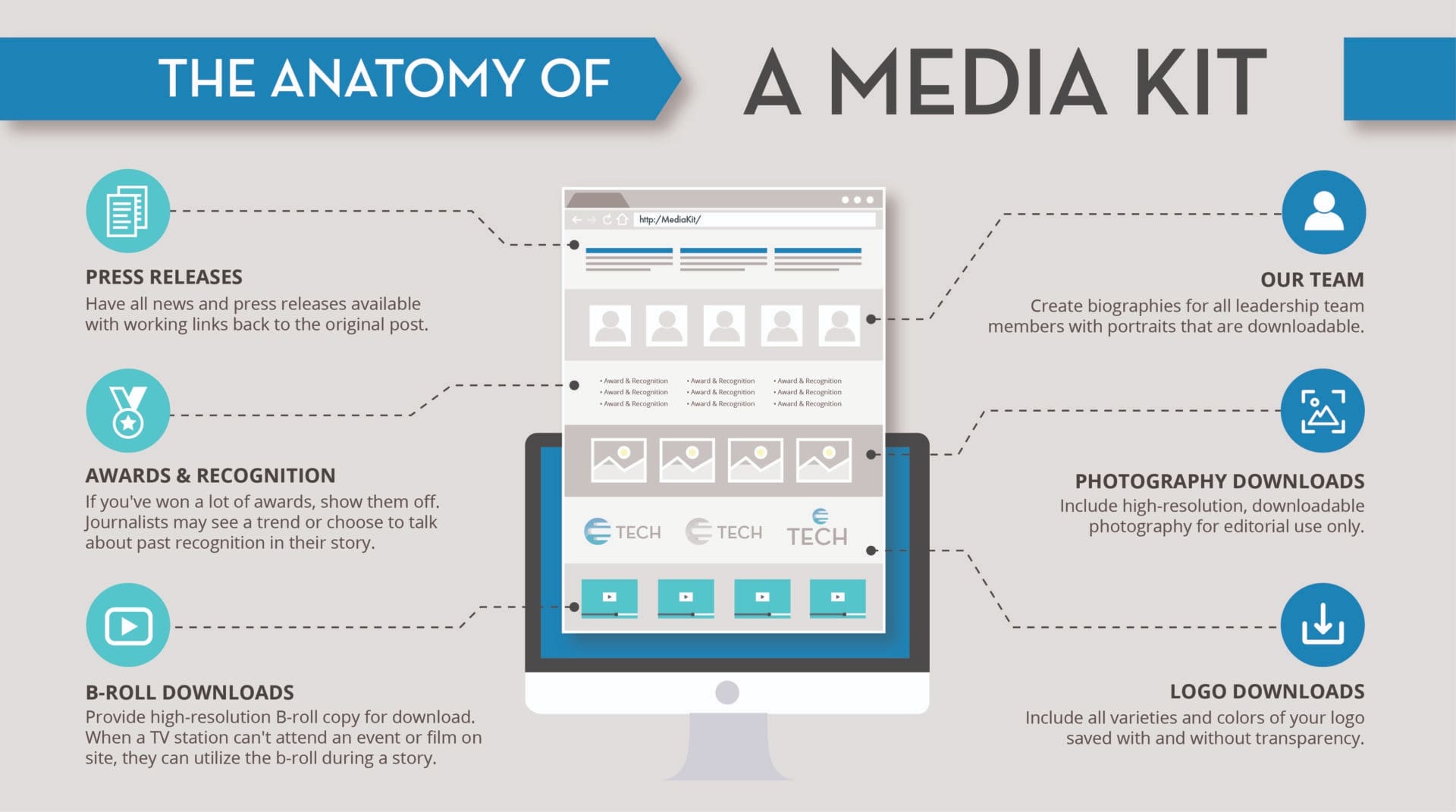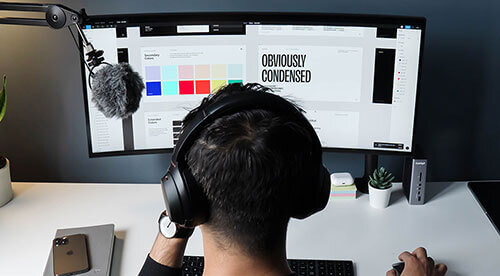Media Kit
How to Make a Media Kit:
5 Simple Steps to Follow
Media kits often serve as the handshake that opens big opportunities. Those who invest time in creating such essential kit packages can get faster success when talking to journalists, influencers, and even potential sponsors.
A well-structured kit is one way to show that the team values clarity and is prepared to engage in branding confidently.
Some believe a media kit is simply a set of promotional materials, but that hardly scratches the surface. A media kit highlights your brand or individual's personality, accentuates the core message, and provides all the details that partners or media contacts crave.
If you're ready to nail this approach, you must create and manage a media kit. Doing so will save you valuable time, especially when a reporter or sponsor is on the other side of an email thread.
Let’s begin by learning more about the media kit, why it matters, and the steps to create it.
What is a Media Kit?
A media kit is a package that contains information summarizing the essence of a brand or individual. It can include a background story, core values, design assets (like logos and headshots), and important data such as social following or press mentions.
Below, we’re going through a quick anatomy of a media kit.

These kits require a solid digital asset management system so that anyone can quickly see, in one spot, what makes a brand tick and why they might want to collaborate.
Let’s dig further into its types and characteristics.
Digital and Printed Media Kit
You can hold two different types of media kits — digital and printed.
Digital Media Kit
A digital kit is an online version that may live on a branded webpage or appear as an interactive PDF.

Click here to explore the Forbes media, which is hosted on Docsend. It typically has clickable links, embedded videos, and instant download options. Such digital kits are super handy because they can be updated on the fly when new press coverage lands or a big partnership goes live.
B. Printed Kits
Then, there are physically printed kits, which have their charm. A visually striking booklet at an event can stay in someone’s memory long after the conference ends.

It often proves that the brand has seriously considered every aspect of its identity.
Characteristics & Uses of a Media Kit
Many brands use a media kit to shape their story since a well-structured version stays concise. It helps others grab the essentials without wading through fluff. Bold visuals often help it stand out, and a quick download setup saves time for everyone involved.
Even here, the media kits vary by industry and audience. For instance, an e-commerce company might highlight company details, product snapshots, and downloadable brand assets such as logos or images.
If sponsorships are part of the package, they could include perks like custom merch created through print-on-demand, adding tangible value to the partnership.
Press coverage usually demands a kit that showcases noteworthy successes or brand evolution. But, a lot of it calls for clarity, a pinch of flair, and easy access to what really matters, whether that’s core values or product info.
Here are the key characteristics to consider.
Conciseness
The writing in the media kit should be concise and keep readers focused on what truly matters. Paragraphs that drone on about every award or event can distract busy media folks.
Visually Appealing
Another piece is visual appeal.

Fonts, colors, and imagery should complement the brand story and leave a lasting impression.
Easy to Share and Download
Next, consider how quick and easy it is to share this media kit, as shareability also ranks high on the checklist.
Are you creating PDF attachments, Google Drive links, or a simple landing page? Make sure the recipients view the kit without fuss.
Usage of Media Kits
Many brands create media kits to share a concise snapshot of who they are and what they offer.
Here are some uses of media kits.
Press Coverage
Journalists and bloggers appreciate a single spot where key facts, quotes, and visuals are all ready to grab.

A media kit gives an efficient shortcut so they don’t have to waste time hunting for relevant details.
Brand Pitches
Business proposals sometimes stall because essential data isn’t easy to find. A polished kit speeds up the conversation by offering everything from brand background to track records.
Speaker Opportunities
Event organizers want to know who they’re inviting on stage. A dedicated kit with bios, headshots, and highlights of past speaking engagements can seal the deal faster than an email chain.
Sponsored Collaborations
Brands or influencers seeking partnerships benefit from giving potential sponsors a look at audience reach, engagement rates, and brand identity.
Steps to Make the Media Kit
Are you someone willing to invest in creating media kits? Then, you’ll have to spend time on skill-based learning and acquiring knowledge on graphic design fundamentals or short-form copywriting.
Below, we’ll explore how to create a media kit. Remember, each section we cover will serve as a stage for important details or striking visuals to take the spotlight.
A little personality, combined with factual data, prompts journalists and sponsors to take the next step.
Below are the essential building blocks and the recommended order to tackle them:
#1. Define Your Purpose & Audience
Avoid the mistake of trying to speak to everyone at once. Goals drive content decisions. A brand that wants press coverage might place founder quotes and strong testimonials at the top.
Another that wants investor interest could highlight growth figures, revenue stats, or product traction.
Identify Your Goals
Journalists, bloggers, influencers, and investors each have separate interests. Those who write articles often look for a compelling backstory, while sponsors might look for evidence of brand synergy or shared values. So, make sure your media kit caters to a singular goal.
Customize Your Content
Some focus on brand stories and press releases, while others emphasize social proof and reach. When preparing the media kit, balance these factors. You must funnel the primary audience and decide on bullet points or sections that resonate with them most.
One kit could branch into specialized versions for specific audiences, too, though many prefer a carefully structured central hub.
#2. Gather & Organize Content
An organized resource stash often makes the difference between a tidy kit and a cluttered mess. Identifying all possible elements early can save headaches when finalizing media kit designs.
Collect Visual Assets
Logos in PNG and JPEG formats help, so you need to include high-resolution product photos, lifestyle images, and brand style guides. A Google Drive folder is a better option for stashing these assets so that you can keep others updated or swap files without confusion.
Compile Key Data
Performance metrics (like web traffic, email newsletter size, and social reach) can highlight the overall impact. Financial milestones or user growth may appeal to serious collaborators or investors. You can also provide it to some influencers, who include audience demographics (age, location, interests), giving prospective partners a sense of targeting accuracy.
Add Compelling Proof Points
Testimonials, quotes from previous press coverage, or short case studies can ease doubts. So, include such proof points in your media kit to add authenticity. It’s here where you can add screenshots or exact quotes.
You can also improve the effectiveness of your media kit by incorporating insights from structured customer feedback, helping you emphasize the aspects of your brand that truly resonate with your audience.
A snippet from a glowing blog post or an excerpt from a testimonial can earn trust faster than a block of marketing talk.
Showcase Your Products or Services
Continue highlighting main offerings concisely. For example, a skincare brand might have product descriptions with neat bullet points on benefits or ingredients.
As a service provider, you must list core packages and success stories that back up those claims. A few product images or screenshots can bring that segment to life.
#3. Focus on Content Structure, Design, and Layout
All the data in the world won’t help if it’s scattered or slapped together with no logic.

So, you’ll need a sensible flow in the media kit design that guides readers so they don't have to hunt for details.
Decide on Format
Some prefer a digital PDF that’s simple to email and complete with clickable links. Others enjoy an online landing page that they can tweak whenever brand news breaks.
Printing a neat booklet still has merit for conferences or in-person meetings. However, those who plan to print can look at various options and compare costs depending on the print quality.
Keep Brand Consistency
No matter the format, visuals should match the brand’s look and feel. Colors, fonts, and images that differ from the company’s website or social platforms might confuse the audience. So, follow a consistent style that helps everything flow and leaves a lasting impression.
Layout Essentials
A strong cover page sets the tone. Adding a brief table of contents is handy when there’s a lot of information. Key sections to include might be “About Us,” “Services/Products,” “Social Proof,” “Partnership Options,” and “Contact.” Ideally, you’ll need to follow a brand guide through some sketch layouts on paper.
Alternatively, use simple design tools like Canva to visualize how each part will be arranged before finalizing.
#4. Blend in Social Media Details
Highlight how your brand or persona thrives on social channels to add a bit of online buzz to your media kit. A short paragraph about your main platforms and audience focus can help readers grasp why your presence matters.
You’ll need to show authentic engagement and focus on past campaigns to make potential collaborators perk up and see the actual value behind those numbers.
Here’s all that you’ll include when presenting your social media work:
- Social Stats: Follower counts, engagement rates, and audience demographics to show where you stand in social media.
- Platform-Specific Highlights: If you rock on Instagram, include a few sample posts and key performance. Have your media kit for Instagram highlight your success.
- Influencer Angles: Collaboration media kit examples, brand deals, and sponsored content analytics that demonstrates real results.
#5. Review, Share & Update Regularly
No kit should gather dust once it’s launched. Regular checks keep stats from going stale and reflect recent partnerships or coverage.
A brand that ramps up from 50K to 100K followers would want that milestone featured, right?
Proofreading
Spelling slip-ups or broken links raise red flags. A quick grammar scan and some link tests can prevent embarrassing moments.
Regular Updates
Fresh stats or new testimonials go a long way. A short revision every quarter might be enough, but major announcements call for immediate tweaks.
Feedback Loop
Team members and trusted partners might spot missing elements or outdated information. Some brands store and share their media kits through a centralized platform so multiple people can contribute.
One way to do so is to use Filecamp. It helps teams manage assets and collaborate on creative files. Those authorized can upload new visuals, tag them, and comment. This ends long email threads or confusion about which version is the latest.
Conclusion
A media kit does more than compile pretty logos and bullet points. It acts like a storybook for your brand, blending facts, figures, and personality into a single resource.
Journalists find quotes, partners spot growth potential, and event organizers see speaker credentials. That’s often enough to open new doors with less back-and-forth and more clarity.
Readers want something that stands out. A kit with purposeful design, polished writing, and straightforward calls to action can leave a memorable impression. Paying a little attention to detail in these steps can spark fresh collaborations and opportunities, sometimes sooner than expected.

Share this Post
